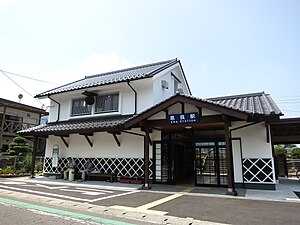Era Station
Era Station 恵良駅 | |||||
|---|---|---|---|---|---|
 Era Station in 2015 | |||||
| General information | |||||
| Location | Kokonoe, Kusu-gun, Ōita-ken Japan | ||||
| Coordinates | 33°15′19″N 131°10′28″E / 33.25528°N 131.17444°E | ||||
| Operated by | |||||
| Line(s) | ■ Kyūdai Main Line | ||||
| Distance | 77.3 km from Kurume | ||||
| Platforms | 2 side platforms | ||||
| Tracks | 2 + 1 siding | ||||
| Construction | |||||
| Structure type | At grade | ||||
| Other information | |||||
| Status | Unstaffed | ||||
| Website | Official website | ||||
| History | |||||
| Opened | 15 December 1929 | ||||
| Rebuilt | 2015 | ||||
| Passengers | |||||
| FY2015 | 41 daily | ||||
| |||||
Era Station (恵良駅, Era-eki) is a railway station on the Kyūdai Main Line in Kokonoe, Ōita Prefecture, Japan.[1][2]
Lines
The station is served by the Kyūdai Main Line and is located 77.3 km from the starting point of the line at Kurume.[3]
Layout
The station consists of two side platforms serving two tracks at grade with a siding. The station building, built in 2015, is a plaster wall traditional Japanese design made to resemble a sake brewery. It houses a waiting area as well as a museum on the history of the town. From the station building, a short flight of steps leads up to platform 1. Access to the opposite side platform is by means of a level crossing.[3][2][4][5]
-
The old station building which burned down in 2014.
Adjacent stations
| « | Service | » | ||
|---|---|---|---|---|
| Kyūdai Main Line | ||||
| Bungo-Mori | Local | Hikiji | ||
History
The private Daito Railway (大湯鉄道) had opened a track between Ōita and Onoya in 1915. The Daito Railway was nationalized on 1 December 1922, after which Japanese Government Railways (JGR) undertook phased westward expansion of the track which, at the time, it had designated as the Daito Line. By 1928, the track had reached Bungo-Nakamura. Subsequently, the track was extended further west and Bungo-Mori was opened as the new western terminus on 15 December 1929. On the same day, Era was opened as an intermediate station along the new track. On 15 November 1934, when the Daito Line had linked up with the Kyudai Main Line further west, JGR designated the station as part of the Kyudai Main Line. With the privatization of Japanese National Railways (JNR), the successor of JGR, on 1 April 1987, the station came under the control of JR Kyushu.[6][7]
In the early hours of 18 January 2014, the original station building built in 1929 and an adjoining residence burned down in a fire.[8][9] Subsequently, the Kokonoe town authorities rebuilt the station building, opening it in March 2015. The new building also housed a museum featuring exhibits about the local sake brewing industry. In keeping with this theme, the station building was designed to resemble the nearby Yatsushika Brewery, complete with a ball of cedar needles indicating that a fresh batch of sake has been brewed. The building is in dozo dzukuri style with white plaster namako walls similar to the station at Chikugo-Yoshii.[10]
Passenger statistics
In fiscal 2015, there were a total of 14,803 boarding passengers, giving a daily average of 41 passengers.[11]
Surrounding area
- Yatsushika sake brewery - the station building was designed to resemble this nearby brewery[12]
- Higashi-Iida Junior High School
- Higashi-Iida Elementary School
See also
References
- ^ "JR Kyushu Route Map" (PDF). JR Kyushu. Retrieved 23 February 2018.
- ^ a b "恵良" [Era]. hacchi-no-he.net. Retrieved 10 April 2018.
- ^ a b Kawashima, Ryōzō (2013). 図説: 日本の鉄道 四国・九州ライン 全線・全駅・全配線・第4巻 福岡エリア [Japan Railways Illustrated. Shikoku and Kyushu. All lines, all stations, all track layouts. Volume 4 Fukuoka Area] (in Japanese). Kodansha. pp. 38, 74. ISBN 9784062951630.
- ^ "久大本線・恵良駅に行ってきました" [I went to Era Station Kyudai Main Line]. Ameblo.jp. 3 August 2015. Retrieved 10 April 2018. Blog entry with good photographic coverage of station facilities.
- ^ "恵良" [Era]. Retrieved 10 April 2018. Another blog entry with good photographic coverage of station facilities.
- ^ Ishino, Tetsu; et al., eds. (1998). 停車場変遷大事典 国鉄・JR編 [Station Transition Directory – JNR/JR] (in Japanese). Vol. I. Tokyo: JTB Corporation. p. 227. ISBN 4-533-02980-9.
- ^ Ishino, Tetsu; et al., eds. (1998). 停車場変遷大事典 国鉄・JR編 [Station Transition Directory – JNR/JR] (in Japanese). Vol. II. Tokyo: JTB Corporation. p. 740. ISBN 4-533-02980-9.
- ^ 棟続き住宅から出火、1929年設置無人駅全焼 [1929 unstaffed station burns down]. Yomiuri Online (in Japanese). Japan: The Yomiuri Shimbun. 19 January 2014. Archived from the original on 26 January 2014. Retrieved 26 January 2014.
- ^ "JR恵良駅が全焼 大分・九重、無人駅" [JR Era Station burns down. Unstaffed station in Kokonoe Ōita]. Nishinihon Shimbun. 18 January 2014. Retrieved 10 April 2018.
- ^ "焼失してしまった駅舎!贅沢な駅舎に生まれ変わりました" [Station building destroyed by fire reborn as luxurious new station building.]. chin-tetsu.com. 10 May 2017. Retrieved 10 April 2018.
- ^ "平成28年版 大分県統計年鑑 11 運輸および通信" [Oita Prefecture Statistics Yearbook 2016 Edition Section 11 Transportation and Communications]. Oita Prefectural Government website. Retrieved 8 April 2018. See table 128 Transport situation by individual railway stations (JR Kyushu JR Freight).
- ^ "八鹿酒造株式会社" [Yatsushika Brewery Company Ltd.]. Retrieved 10 April 2018.
External links
- Era (JR Kyushu)(in Japanese)


